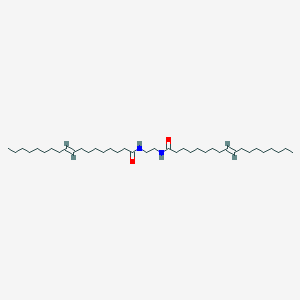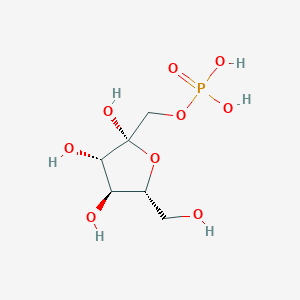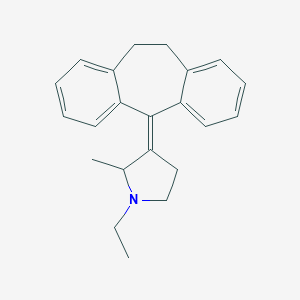
1,4-Dimethylpiperazin
Übersicht
Beschreibung
1,4-Dimethylpiperazine is an organic compound with the molecular formula C₆H₁₄N₂. It is a derivative of piperazine, where two hydrogen atoms on the nitrogen atoms are replaced by methyl groups. This compound is known for its use as an intermediate in the synthesis of various pharmaceuticals and as a catalyst in chemical reactions .
Wissenschaftliche Forschungsanwendungen
1,4-Dimethylpiperazine has a wide range of applications in scientific research:
Chemistry: It is used as a catalyst for polyurethane foams and as an intermediate for cationic surfactants.
Biology: It is used in the synthesis of various biologically active compounds.
Medicine: It serves as an intermediate in the synthesis of pharmaceuticals, including drugs with piperazine moieties.
Industry: It is used in the production of polymers and as a stabilizer in various industrial processes.
Wirkmechanismus
Target of Action
1,4-Dimethylpiperazine primarily acts as a catalyst for polyurethane foams and an intermediate for cationic surfactants . It plays a crucial role in the production of these materials, facilitating the necessary chemical reactions.
Mode of Action
As a catalyst, 1,4-Dimethylpiperazine accelerates the chemical reactions involved in the formation of polyurethane foams. It does this by reducing the activation energy required for the reaction, enabling it to proceed at a faster rate or at a lower temperature .
Biochemical Pathways
It’s known that it plays a role in the synthesis of polyurethane foams and cationic surfactants .
Result of Action
The primary result of 1,4-Dimethylpiperazine’s action is the formation of polyurethane foams and cationic surfactants . These materials have a wide range of applications, from insulation and cushioning to detergents and fabric softeners.
Action Environment
Environmental factors can influence the action, efficacy, and stability of 1,4-Dimethylpiperazine. For instance, temperature and pressure can affect the rate at which it catalyzes reactions . Proper storage conditions, such as storing it below +30°C, are necessary to maintain its stability .
Biochemische Analyse
Biochemical Properties
It is known that it is a very water-soluble substance (> 1000 g/L) with a moderate partition coefficient (log P -0.26 at 20°C and pH 8.0-8.3) This suggests that it may interact with various enzymes, proteins, and other biomolecules in a biochemical context
Molecular Mechanism
It is known that it can interact with other molecules due to its chemical structure . The specifics of these interactions, including any binding interactions with biomolecules, enzyme inhibition or activation, and changes in gene expression, are not currently known.
Temporal Effects in Laboratory Settings
Information on the product’s stability, degradation, and any long-term effects on cellular function observed in in vitro or in vivo studies is currently lacking .
Dosage Effects in Animal Models
There is currently no available information on the effects of different dosages of 1,4-Dimethylpiperazine in animal models .
Metabolic Pathways
It is known that it can interact with other molecules due to its chemical structure , but the specifics of these interactions, including any effects on metabolic flux or metabolite levels, are not currently known .
Transport and Distribution
It is known that it is a very water-soluble substance , which suggests that it could be transported and distributed within cells and tissues. The specifics of these processes, including any transporters or binding proteins that it interacts with, as well as any effects on its localization or accumulation, are not currently known.
Subcellular Localization
It is known that it is a very water-soluble substance , which suggests that it could be localized in various subcellular compartments. The specifics of this localization, including any targeting signals or post-translational modifications that direct it to specific compartments or organelles, are not currently known .
Vorbereitungsmethoden
Synthetic Routes and Reaction Conditions
1,4-Dimethylpiperazine can be synthesized through several methods. One common method involves the reaction of N-methyldiethanolamine with hydrogen and monomethylamine in the presence of a catalyst. The reaction mixture is introduced into a tubular fixed bed reactor filled with a rare earth element-modified copper-based composite catalyst. The raw materials are gasified at high temperatures, and the mixed gas contacts the catalyst to form 1,4-dimethylpiperazine. The reaction mixture is then condensed, collected, and purified to obtain high-purity 1,4-dimethylpiperazine .
Industrial Production Methods
The industrial production of 1,4-dimethylpiperazine typically follows the same synthetic route as described above. The use of a tubular fixed bed reactor and a rare earth element-modified copper-based composite catalyst ensures high catalytic activity and simple industrial scale-up .
Analyse Chemischer Reaktionen
Types of Reactions
1,4-Dimethylpiperazine undergoes various chemical reactions, including:
Oxidation: It can be oxidized to form corresponding N-oxides.
Reduction: It can be reduced to form piperazine derivatives.
Substitution: It can undergo nucleophilic substitution reactions to form various substituted piperazines.
Common Reagents and Conditions
Oxidation: Common oxidizing agents include hydrogen peroxide and peracids.
Reduction: Common reducing agents include lithium aluminum hydride and sodium borohydride.
Substitution: Common reagents include alkyl halides and acyl chlorides.
Major Products Formed
Oxidation: N-oxides of 1,4-dimethylpiperazine.
Reduction: Piperazine derivatives.
Substitution: Substituted piperazines with various functional groups.
Vergleich Mit ähnlichen Verbindungen
Similar Compounds
Piperazine: The parent compound of 1,4-dimethylpiperazine, with two hydrogen atoms on the nitrogen atoms.
1-Methylpiperazine: A derivative with one methyl group on one of the nitrogen atoms.
N,N’-Dimethylpiperazine: Another name for 1,4-dimethylpiperazine.
Uniqueness
1,4-Dimethylpiperazine is unique due to its specific substitution pattern, which imparts distinct chemical and physical properties. Its ability to act as a catalyst and intermediate in various chemical reactions makes it valuable in both research and industrial applications .
Eigenschaften
IUPAC Name |
1,4-dimethylpiperazine | |
|---|---|---|
| Source | PubChem | |
| URL | https://pubchem.ncbi.nlm.nih.gov | |
| Description | Data deposited in or computed by PubChem | |
InChI |
InChI=1S/C6H14N2/c1-7-3-5-8(2)6-4-7/h3-6H2,1-2H3 | |
| Source | PubChem | |
| URL | https://pubchem.ncbi.nlm.nih.gov | |
| Description | Data deposited in or computed by PubChem | |
InChI Key |
RXYPXQSKLGGKOL-UHFFFAOYSA-N | |
| Source | PubChem | |
| URL | https://pubchem.ncbi.nlm.nih.gov | |
| Description | Data deposited in or computed by PubChem | |
Canonical SMILES |
CN1CCN(CC1)C | |
| Source | PubChem | |
| URL | https://pubchem.ncbi.nlm.nih.gov | |
| Description | Data deposited in or computed by PubChem | |
Molecular Formula |
C6H14N2 | |
| Source | PubChem | |
| URL | https://pubchem.ncbi.nlm.nih.gov | |
| Description | Data deposited in or computed by PubChem | |
DSSTOX Substance ID |
DTXSID8051544 | |
| Record name | 1,4-Dimethylpiperazine | |
| Source | EPA DSSTox | |
| URL | https://comptox.epa.gov/dashboard/DTXSID8051544 | |
| Description | DSSTox provides a high quality public chemistry resource for supporting improved predictive toxicology. | |
Molecular Weight |
114.19 g/mol | |
| Source | PubChem | |
| URL | https://pubchem.ncbi.nlm.nih.gov | |
| Description | Data deposited in or computed by PubChem | |
Physical Description |
Liquid | |
| Record name | Piperazine, 1,4-dimethyl- | |
| Source | EPA Chemicals under the TSCA | |
| URL | https://www.epa.gov/chemicals-under-tsca | |
| Description | EPA Chemicals under the Toxic Substances Control Act (TSCA) collection contains information on chemicals and their regulations under TSCA, including non-confidential content from the TSCA Chemical Substance Inventory and Chemical Data Reporting. | |
Vapor Pressure |
5.22 [mmHg] | |
| Record name | N,N'-Dimethylpiperazine | |
| Source | Haz-Map, Information on Hazardous Chemicals and Occupational Diseases | |
| URL | https://haz-map.com/Agents/2217 | |
| Description | Haz-Map® is an occupational health database designed for health and safety professionals and for consumers seeking information about the adverse effects of workplace exposures to chemical and biological agents. | |
| Explanation | Copyright (c) 2022 Haz-Map(R). All rights reserved. Unless otherwise indicated, all materials from Haz-Map are copyrighted by Haz-Map(R). No part of these materials, either text or image may be used for any purpose other than for personal use. Therefore, reproduction, modification, storage in a retrieval system or retransmission, in any form or by any means, electronic, mechanical or otherwise, for reasons other than personal use, is strictly prohibited without prior written permission. | |
CAS No. |
106-58-1 | |
| Record name | 1,4-Dimethylpiperazine | |
| Source | CAS Common Chemistry | |
| URL | https://commonchemistry.cas.org/detail?cas_rn=106-58-1 | |
| Description | CAS Common Chemistry is an open community resource for accessing chemical information. Nearly 500,000 chemical substances from CAS REGISTRY cover areas of community interest, including common and frequently regulated chemicals, and those relevant to high school and undergraduate chemistry classes. This chemical information, curated by our expert scientists, is provided in alignment with our mission as a division of the American Chemical Society. | |
| Explanation | The data from CAS Common Chemistry is provided under a CC-BY-NC 4.0 license, unless otherwise stated. | |
| Record name | N,N'-Dimethylpiperazine | |
| Source | ChemIDplus | |
| URL | https://pubchem.ncbi.nlm.nih.gov/substance/?source=chemidplus&sourceid=0000106581 | |
| Description | ChemIDplus is a free, web search system that provides access to the structure and nomenclature authority files used for the identification of chemical substances cited in National Library of Medicine (NLM) databases, including the TOXNET system. | |
| Record name | 1,4-Dimethylpiperazine | |
| Source | DTP/NCI | |
| URL | https://dtp.cancer.gov/dtpstandard/servlet/dwindex?searchtype=NSC&outputformat=html&searchlist=41177 | |
| Description | The NCI Development Therapeutics Program (DTP) provides services and resources to the academic and private-sector research communities worldwide to facilitate the discovery and development of new cancer therapeutic agents. | |
| Explanation | Unless otherwise indicated, all text within NCI products is free of copyright and may be reused without our permission. Credit the National Cancer Institute as the source. | |
| Record name | Piperazine, 1,4-dimethyl- | |
| Source | EPA Chemicals under the TSCA | |
| URL | https://www.epa.gov/chemicals-under-tsca | |
| Description | EPA Chemicals under the Toxic Substances Control Act (TSCA) collection contains information on chemicals and their regulations under TSCA, including non-confidential content from the TSCA Chemical Substance Inventory and Chemical Data Reporting. | |
| Record name | 1,4-Dimethylpiperazine | |
| Source | EPA DSSTox | |
| URL | https://comptox.epa.gov/dashboard/DTXSID8051544 | |
| Description | DSSTox provides a high quality public chemistry resource for supporting improved predictive toxicology. | |
| Record name | 1,4-dimethylpiperazine | |
| Source | European Chemicals Agency (ECHA) | |
| URL | https://echa.europa.eu/substance-information/-/substanceinfo/100.003.103 | |
| Description | The European Chemicals Agency (ECHA) is an agency of the European Union which is the driving force among regulatory authorities in implementing the EU's groundbreaking chemicals legislation for the benefit of human health and the environment as well as for innovation and competitiveness. | |
| Explanation | Use of the information, documents and data from the ECHA website is subject to the terms and conditions of this Legal Notice, and subject to other binding limitations provided for under applicable law, the information, documents and data made available on the ECHA website may be reproduced, distributed and/or used, totally or in part, for non-commercial purposes provided that ECHA is acknowledged as the source: "Source: European Chemicals Agency, http://echa.europa.eu/". Such acknowledgement must be included in each copy of the material. ECHA permits and encourages organisations and individuals to create links to the ECHA website under the following cumulative conditions: Links can only be made to webpages that provide a link to the Legal Notice page. | |
| Record name | 1,4-DIMETHYLPIPERAZINE | |
| Source | FDA Global Substance Registration System (GSRS) | |
| URL | https://gsrs.ncats.nih.gov/ginas/app/beta/substances/TF146U602L | |
| Description | The FDA Global Substance Registration System (GSRS) enables the efficient and accurate exchange of information on what substances are in regulated products. Instead of relying on names, which vary across regulatory domains, countries, and regions, the GSRS knowledge base makes it possible for substances to be defined by standardized, scientific descriptions. | |
| Explanation | Unless otherwise noted, the contents of the FDA website (www.fda.gov), both text and graphics, are not copyrighted. They are in the public domain and may be republished, reprinted and otherwise used freely by anyone without the need to obtain permission from FDA. Credit to the U.S. Food and Drug Administration as the source is appreciated but not required. | |
Synthesis routes and methods
Procedure details













Retrosynthesis Analysis
AI-Powered Synthesis Planning: Our tool employs the Template_relevance Pistachio, Template_relevance Bkms_metabolic, Template_relevance Pistachio_ringbreaker, Template_relevance Reaxys, Template_relevance Reaxys_biocatalysis model, leveraging a vast database of chemical reactions to predict feasible synthetic routes.
One-Step Synthesis Focus: Specifically designed for one-step synthesis, it provides concise and direct routes for your target compounds, streamlining the synthesis process.
Accurate Predictions: Utilizing the extensive PISTACHIO, BKMS_METABOLIC, PISTACHIO_RINGBREAKER, REAXYS, REAXYS_BIOCATALYSIS database, our tool offers high-accuracy predictions, reflecting the latest in chemical research and data.
Strategy Settings
| Precursor scoring | Relevance Heuristic |
|---|---|
| Min. plausibility | 0.01 |
| Model | Template_relevance |
| Template Set | Pistachio/Bkms_metabolic/Pistachio_ringbreaker/Reaxys/Reaxys_biocatalysis |
| Top-N result to add to graph | 6 |
Feasible Synthetic Routes
Haftungsausschluss und Informationen zu In-Vitro-Forschungsprodukten
Bitte beachten Sie, dass alle Artikel und Produktinformationen, die auf BenchChem präsentiert werden, ausschließlich zu Informationszwecken bestimmt sind. Die auf BenchChem zum Kauf angebotenen Produkte sind speziell für In-vitro-Studien konzipiert, die außerhalb lebender Organismen durchgeführt werden. In-vitro-Studien, abgeleitet von dem lateinischen Begriff "in Glas", beinhalten Experimente, die in kontrollierten Laborumgebungen unter Verwendung von Zellen oder Geweben durchgeführt werden. Es ist wichtig zu beachten, dass diese Produkte nicht als Arzneimittel oder Medikamente eingestuft sind und keine Zulassung der FDA für die Vorbeugung, Behandlung oder Heilung von medizinischen Zuständen, Beschwerden oder Krankheiten erhalten haben. Wir müssen betonen, dass jede Form der körperlichen Einführung dieser Produkte in Menschen oder Tiere gesetzlich strikt untersagt ist. Es ist unerlässlich, sich an diese Richtlinien zu halten, um die Einhaltung rechtlicher und ethischer Standards in Forschung und Experiment zu gewährleisten.













![3-HEPTYL-2-[(3-HEPTYL-4-METHYL-1,3-THIAZOL-2-YLIDENE)METHYL]-4-METHYL-1,3-THIAZOL-3-IUM IODIDE](/img/structure/B91365.png)
